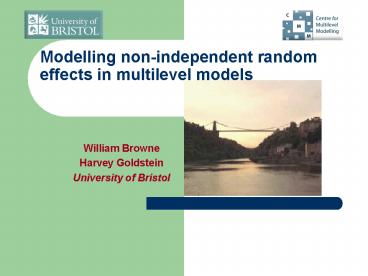Modelling nonindependent random effects in multilevel models - PowerPoint PPT Presentation
1 / 13
Title:
Modelling nonindependent random effects in multilevel models
Description:
Modelling non-independent random effects in multilevel models. William Browne. Harvey Goldstein ... Repeated measures growth models with closely spaced occasions ... – PowerPoint PPT presentation
Number of Views:85
Avg rating:3.0/5.0
Title: Modelling nonindependent random effects in multilevel models
1
Modelling non-independent random effects in
multilevel models
- William Browne
- Harvey Goldstein
- University of Bristol
2
A standard multilevel (VC) model
Fixed Random level 2 level 1
residual
The are assumed independent.
- But this is sometimes unrealistic
- Repeated measures growth models with closely
spaced occasions - Schools competing for resources in a zero-sum
environment
3
Repeated measures growth curves
- A simple model of linear growth with random
slopes
A model for (non-independent) level 1 residuals
might be written
Leading to an exponential decay function.
(Goldstein and Healy 1994)
4
Schools in competition
where this correlation is inversely proportional
to the (resource) distance between the schools
. If we can specify a suitable (set of )
distance functions then we can estimate the
relevant parameters. One possibility is to use
the extent of overlap between appropriately
defined catchment areas. Work using the ALSPAC
cohort is currently underway.
5
Other link functions
Logit Log
These have the following forms
6
Link functions
Link function f(s). From left to right
hyperbolic, logit, log
7
Parameters and estimation
- We need to estimate the parameters of the
correlation function, the variances and the fixed
effects. - We propose an MCMC algorithm and have programmed
this for general 2- level models where
correlations can exist at either or both levels
and responses can be normal or binary. - Steps are a mixture of Gibbs and MH sampling with
adaptive proposal distributions and suitable
diffuse priors
8
Example 1 Growth data
- The data are 9 measurements on 20 boys around
age 13, approximately 3 months apart - Fitting a 2-level model with random linear and
quadratic coefficients does not remove residual
autocorrelation among level 1 residuals. - We model the correlation as a negative
exponentially decreasing function of the time
difference - We use a log (exponential) link since
correlations should be positive - In discrete time (equal intervals) this is a
standard first order autoregressive model - We fit a 4-th degree polynomial with and without
random linear coefficient
9
Results
random slope
Intercept only
For model A the correlation between measurements
0.25 years apart is 0.73 and for model B is 0.996.
10
An equivalence
- For a 2-level variance components model the full
covariance matrix among the level 1 units in a
level 2 unit can be written in the form
where in this case there are 4 level 1 units. For
the model with an equal correlation structure at
level 1 and no level 2 variation the
corresponding covariance matrix is equivalent,
namely
11
A level 2 example dependence based on distance
apart
- We have a three level model consisting of
schools at level 3, cohorts or year groups at
level 2 (2004,2005,2006) and students at level 1.
The data are taken from the PLASC/NPD database
response is GCSE score and predictors include 11
year KS test score - We fit as a 2-level model (school cohorts at
level 2) with a correlation structure between
cohorts within schools and dummies for years
So that the correlation is modelled by a constant
decreasing function of time difference
12
RESULTS
13
Conclusions
- These models provide a useful generalisation to
standard independence models and are readily
extended to non-normal responses, cross
classifications etc. - They allow us to more realistically describe the
behaviour of institutions that are interactive
rather than independently behaving units































